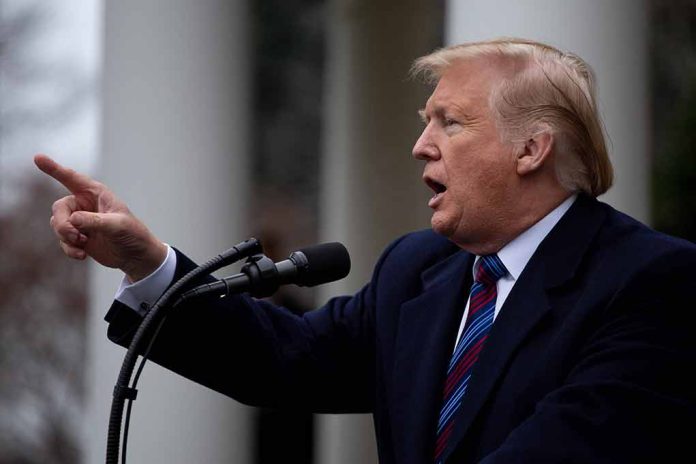
President Trump unveils a dual-track immigration strategy that would deport illegal immigrants while allowing some to return legally for essential jobs in agriculture and hospitality sectors.
Key Takeaways
- Trump proposes a “self-deportation” program with a potential 60-day deadline for illegal immigrants to leave voluntarily before being eligible for legal reentry.
- The plan includes provisions to work with farmers to allow certain workers recommended by employers to temporarily remain or return through legal channels.
- Over 5,000 immigrants have already self-deported in the past month according to Department of Homeland Security data.
- Critics like Mark Krikorian from the Center for Immigration Studies warn the policy could function as a “guestworker amnesty” that undermines wage growth and discourages investment in labor-saving technology.
- The administration is developing support programs to assist deported immigrants in their home countries with food and housing assistance.
Self-Deportation with a Path to Legal Return
Donald Trump has outlined a comprehensive immigration enforcement plan that balances strict enforcement with economic practicality. The initiative centers on encouraging illegal immigrants to depart voluntarily with the promise that those who comply may have a path to return legally, particularly if they work in industries facing labor shortages. Trump has suggested a 60-day window for self-deportation, with the entire exit and return process potentially taking about two months to complete.
Homeland Security Secretary Kristi Noem has characterized the effort as “a very big self-deport operation,” noting that the administration is actively encouraging undocumented immigrants to register through the CBP Home app and return to their countries of origin. This approach aims to create an orderly process while avoiding the chaos and humanitarian concerns that might accompany mass forced deportations. Officials report that this strategy is already yielding results, with thousands choosing to leave voluntarily.
Remember about a wk ago when Trump told people here illegally to self deport using the CBP1 app
Fox News is reporting that (5K) have self deported ~ per DHS
Trump ~ you can deport the easy way or get deported the hard way…. they chose the easy way… and left on their own 👍 pic.twitter.com/bZJpfCmBSM
— @Chicago1Ray 🇺🇸 (@Chicago1Ray) April 11, 2025
Industry-Specific Worker Provisions
The Trump plan acknowledges the economic reality that certain sectors of the American economy have developed a significant dependence on immigrant labor. In particular, the agricultural and hospitality industries have expressed concerns about potential labor shortages if all undocumented workers were removed without replacement. To address this, Trump has proposed working directly with employers to identify essential workers who might qualify for temporary legal status or expedited return. “We’re also going to work with farmers that if they have strong recommendations for their farms for certain people, we’re going to let them stay in for a while and work with the farmers and go through a process, a legal process” announced Trump.
This industry-focused approach attempts to strike a balance between enforcing immigration laws and preventing economic disruption. The administration appears to be developing a system for employers to make recommendations for workers they deem essential, potentially creating a pathway for some migrants to remain temporarily or return quickly through legal channels. This reflects pressure from business interests concerned about potential profit impacts from labor shortages and resulting wage increases.
Support Systems and Criticisms
The administration is working to establish support systems for those who self-deport, including programs offering food and housing assistance in their home countries. Secretary Noem has emphasized that these efforts are designed to ensure that those who leave voluntarily have the necessary resources as they transition back to their countries of origin. This focus on humane treatment appears designed to encourage compliance with the self-deportation initiative while mitigating humanitarian concerns.
Critics of the plan have raised significant concerns about its implementation and potential economic impacts. Mark Krikorian from the Center for Immigration Studies has compared the approach to historical programs that temporarily removed and then readmitted agricultural workers, characterizing Trump’s proposal as a “guestworker amnesty” that could undermine wage growth for American workers. He further argues that such policies reduce employers’ incentives to invest in labor-saving technologies that could boost productivity in agricultural and hospitality sectors.
Balancing Enforcement and Economic Needs
Trump’s immigration proposal represents an attempt to fulfill campaign promises for strict immigration enforcement while acknowledging economic realities. By creating a system that combines deportation with legal pathways for return, the administration is seeking to assert control over immigration while avoiding economic disruption in key sectors. The success of this balanced approach will likely depend on implementation details that have yet to be fully developed.
Sources:
Donald Trump Sketches Plan to Deport Many and Recall Some Migrants for Farm, Hotel Jobs



